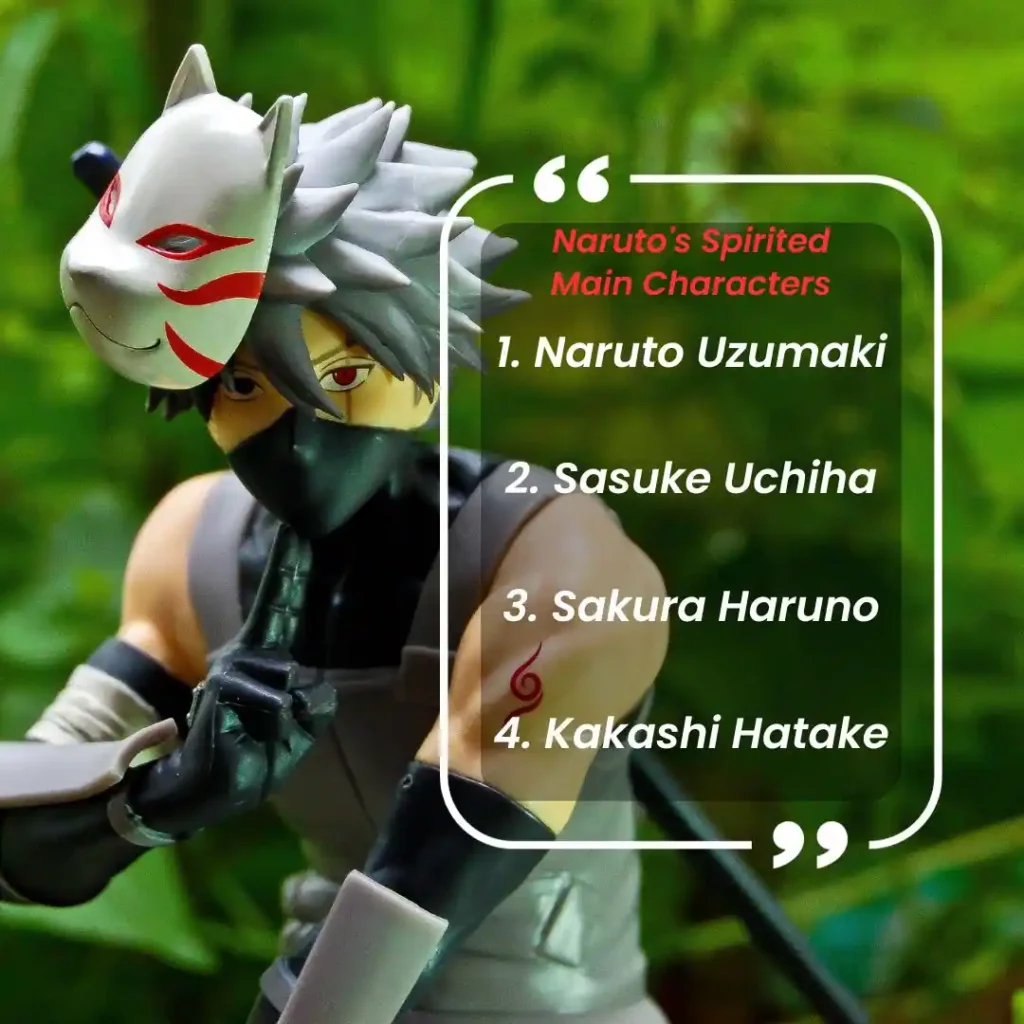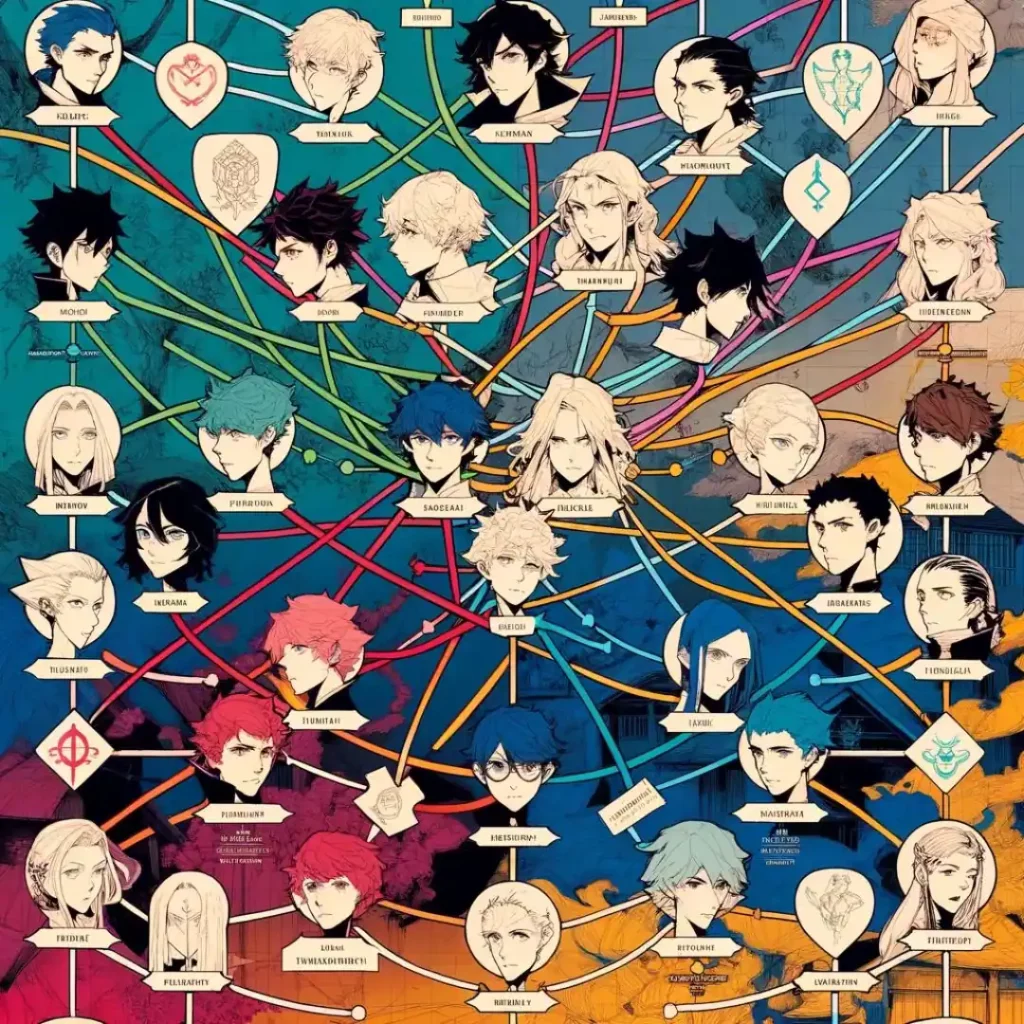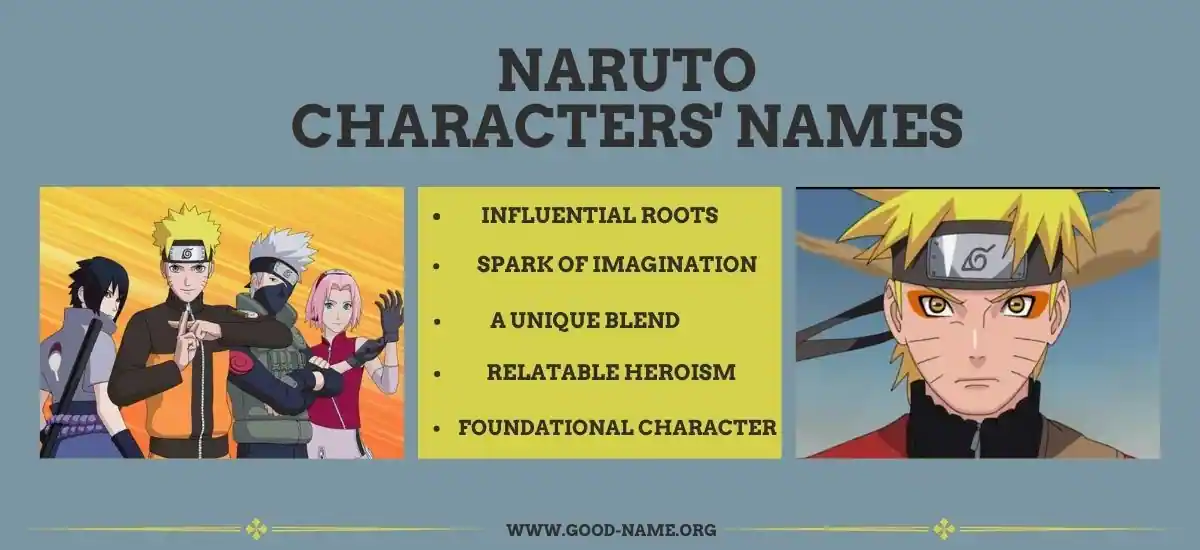Welcome to the vibrant and thrilling universe of “Naruto Characters Names,” where each character is a unique blend of courage, creativity, and charisma! This enchanting world, crafted by the genius of Masashi Kishimoto, has become a global sensation, captivating the hearts and imaginations of countless fans. Our guide invites you on an exhilarating adventure to explore the depth and diversity of the characters that define this iconic series.
From the whirlwind of energy that is Naruto Uzumaki, whose dreams and determination redefine what it means to be a hero, to the enigmatic and evolving next generation led by Boruto, each character weaves a story of their own. These tales are not just narratives; they are life lessons in resilience, friendship, and the relentless pursuit of one’s dreams.
As we delve into this universe, we’ll encounter stories that resonate with growth, challenge, and the indomitable spirit of overcoming the odds. It’s a world where each ninja’s journey is a mirror to our struggles and triumphs, making the Naruto series much more than just a story – it’s an inspiring saga that encourages us to believe in ourselves and in the power of our dreams.
Join us in this joyful exploration of the Naruto universe, a journey that promises to be as unforgettable as it is transformative, filled with heart-pounding action, profound wisdom, and an unbreakable spirit of adventure!
Inspiring Creation Of Naruto Characters
- Spark of Imagination: Masashi Kishimoto’s vision birthed the Naruto universe, a fusion of his creative genius and inspiration drawn from shōnen manga.
- Influential Roots: Kishimoto found significant inspiration in the iconic “Dragon Ball” series, particularly embracing the lively and adventurous spirit epitomized by Goku.
- Naruto Uzumaki’s Birth: Naruto was meticulously crafted to embody the quintessential shōnen hero – energetic, mischievous, and overflowing with untapped potential.
- A Unique Blend: The series distinguishes itself through a captivating blend of exhilarating adventures and characters boasting deep, emotionally resonant narratives.
- Relatable Heroism: Naruto’s transformative journey from outcast to beloved hero mirrors universal struggles and triumphs, creating a narrative that resonates with audiences worldwide.
- Foundational Character: Naruto serves as the cornerstone for a narrative universe, setting the stage for a diverse cast of characters, each embarking on their unique and compelling journey.
Check On: Trendy Kik Usernames For Every Style
Naruto’s Spirited Main Characters

1. Naruto Uzumaki: His Energetic Path To Hokage
Naruto Uzumaki is not just a character; he’s an emotion, an embodiment of perseverance and an unyielding spirit. From the moment Naruto proclaimed his dream of becoming Hokage, he captured the essence of hope and resilience.
His journey is marked by challenges, growth, and an unwavering commitment to his goals and friends. Naruto’s character teaches us the power of belief and the importance of staying true to oneself.
2. Sasuke Uchiha: The Cool Genius And His Journey
Sasuke Uchiha, the brooding and brilliant rival of Naruto, presents a complex tapestry of talent, trauma, and tenacity. Designed as the “cool genius,” Sasuke’s story is a whirlwind of revenge, redemption, and introspection.
His evolution from a revenge-driven loner to a protector of the world is a narrative of overcoming the shadows of the past and finding new reasons to fight.
3. Sakura Haruno: The Blossoming Of A Strong Kunoichi
Sakura Haruno’s journey is a powerful portrayal of growth and empowerment. Initially seen as infatuated with Sasuke and dismissive of Naruto, Sakura evolves into a formidable kunoichi.
Her transformation highlights the importance of inner strength, the value of hard work, and the courage to stand equal among legends.
4. Kakashi Hatake: The Wise And Witty Mentor
Kakashi Hatake, the leader of Team 7, brings a blend of wisdom, skill, and a touch of mystery. With a past shrouded in tragedy, Kakashi’s calm and collected demeanor hides a deep sense of care and responsibility towards his students.
He is the guiding force behind Team 7’s growth, embodying the qualities of a true mentor.
| Character | Role |
| Naruto Uzumaki | Protagonist, Hokage |
| Sasuke Uchiha | Main character, Avenger |
| Sakura Haruno | Team 7 member, Medical Ninja |
| Kakashi Hatake | Team 7 leader, Sensei |
| Hinata Hyuga | Supportive character, Hyuga Clan |
| Shikamaru Nara | Strategist, Advisor |
| Gaara | Kazekage, Former Antagonist |
| Jiraiya | Legendary Sannin, Mentor |
| Tsunade | Hokage, Legendary Sannin |
| Orochimaru | Former Team 7 Leader, Antagonist |
| Rock Lee | Hardworking Ninja, Taijutsu Master |
| Neji Hyuga | Hyuga Clan, Byakugan |
| Itachi Uchiha | Complex Antagonist, Uchiha Clan |
| Ino Yamanaka | Team 10 member, Mind-Transfer Jutsu |
| Kiba Inuzuka | Team 8 member, Beastmaster |
| Tenten | Weapons Specialist |
| Shino Aburame | Team 8 member, Insect User |
| Minato Namikaze | Fourth Hokage, Naruto’s Father |
| Kushina Uzumaki | Naruto’s Mother, Uzumaki Clan |
| Tsunade | Fifth Hokage, Legendary Sannin |
| Boruto Uzumaki | Protagonist (Boruto series) |
| Sarada Uchiha | Team 7 member (Boruto series) |
| Mitsuki | Team 7 member (Boruto series) |
Please note that there are many more characters in the Naruto series, each with their unique roles and contributions to the story.
Team 7’s Heartwarming Journey

- Formation of Team 7: Comprising Naruto, Sasuke, Sakura, and led by Kakashi, Team 7 begins as a diverse mix of personalities and dreams.
- Early Struggles: Initial fragmentation occurs due to differing ambitions and traits; Naruto’s enthusiasm clashes with Sasuke’s brooding nature, and Sakura’s affections for Sasuke add complexity.
- Growth Through Adversity: Despite early challenges, the team grows closer, learning invaluable lessons in friendship, loyalty, and teamwork.
- Symbol of Unity: Team 7 evolves into a powerful symbol of unity and collective strength, overcoming personal and external obstacles.
- Emotional Disbandment: The team’s separation marks a significant emotional phase, reflecting the trials of growth and change.
- Reunion and Resilience: Their eventual reunion is a testament to enduring bonds, showcasing how shared experiences and mutual respect can reunite and strengthen relationships.
- Lasting Impact: Team 7’s journey is a heartwarming tale of how friendship and understanding can transform individuals and forge unbreakable bonds.
The Formation And Challenges
- Rocky Beginnings: Team 7’s initial dynamics were tumultuous, marked by Naruto’s exuberance clashing with Sasuke’s calm and reserved nature.
- Unbalanced Relationships: Sakura’s strong feelings for Sasuke created a lopsided dynamic within the team, adding to the initial tension.
- Kakashi’s Role: Under Kakashi’s wise and patient guidance, the team began to learn crucial lessons in cooperation and mutual respect.
- Importance of Teamwork: The team’s various missions served as critical learning grounds, emphasizing the value of working together and supporting each other.
- Building Trust: Through shared struggles and successes, Naruto, Sasuke, and Sakura gradually developed a deep sense of trust and camaraderie.
- Understanding True Strength: Team 7’s experiences helped them understand that true strength lies not just in individual skills but in unity and collective effort.
- Personal Growth: Each challenge and mission contributed significantly to their personal growth, helping them understand themselves and each other better.
The Reunion: A Testament To Enduring Bonds
- Paths Diverge: In the series’ latter part, Team 7 dissolves as each member pursues their individual journey, reflecting their growth and evolving aspirations.
- Enduring Connections: Despite their separation, the deep-rooted bonds forged through shared experiences keep the essence of Team 7 alive.
- Reunion of Hearts and Minds: The emotional reunion of Team 7 is a testament to the enduring nature of their friendship and mutual respect.
- Symbol of Resilience: Their coming together symbolizes the triumph of collective strength and unity over individual hardships and internal conflicts.
- Affirmation of Shared History: The reunion is a poignant reminder of their shared past, highlighting how their experiences shaped each member’s path.
- Celebration of Growth: This moment celebrates the personal growth of Naruto, Sasuke, and Sakura, showcasing their development from young ninjas into mature individuals.
- Power of Teamwork Reinforced: The reunion reinforces the series’ theme that true strength lies in unity and collaborative effort, more than in solitary pursuits.
Delightful Secondary Characters And Their Stories

The Naruto series is embellished with a kaleidoscope of secondary characters, each adding depth and color to the narrative. These characters, ranging from fellow ninja team members to mentors and village elders, play crucial roles in shaping the journey of the main characters and the story’s progression.
- Shikamaru Nara: Known for his strategic mind and laid-back attitude, Shikamaru is a genius at strategy, often seen as lazy due to his laid-back nature. His development from a reluctant fighter to a responsible leader is significant, especially his deep involvement in the Sasuke Retrieval arc and his later role as Naruto’s advisor.
- Rock Lee: The epitome of perseverance, Rock Lee is unable to use most ninja techniques but compensates with his mastery of taijutsu. His story is one of overcoming physical limitations through sheer willpower and hard work, highlighted in his memorable battle against Gaara.
- Hinata Hyuga: Initially shy and lacking confidence, Hinata’s admiration for Naruto helps her overcome her insecurities. Her journey is about self-acceptance and finding inner strength, culminating in her crucial role during the Fourth Great Ninja War and her eventual marriage to Naruto.
- Neji Hyuga: Neji begins as a fatalistic character, believing one’s destiny is fixed. His encounters with Naruto change his perspective, leading to significant character growth. His sacrifice during the war arc is a pivotal moment, showcasing his development from a bitter genius to a noble protector.
- Kiba Inuzuka: Paired with his canine companion Akamaru, Kiba is impulsive and headstrong. His story focuses on his bond with Akamaru and his competitive nature, often providing comic relief and a sense of camaraderie within the Inuzuka clan.
- Tenten: A weapons specialist, Tenten is characterized by her determination and dedication to being a strong kunoichi. Though not as prominently featured, her role in supporting her team and her dream of becoming a legendary female ninja adds depth to her character.
- Choji Akimichi: Choji’s story revolves around themes of self-worth and friendship. Often teased for his weight, he shows immense courage and loyalty, particularly in the Sasuke Retrieval arc, where he fights bravely for his friends.
- Ino Yamanaka: Ino’s journey involves her rivalry with Sakura and her growth from being fixated on appearances to becoming a skilled and caring ninja. Her abilities in mind-transfer jutsu and her role in intelligence gathering during the war highlight her development.
- Gaara: Initially introduced as a villain, Gaara’s transformation is one of the most profound. His journey from a lonely, bitter individual to the Kazekage of Sunagakure is deeply intertwined with Naruto’s influence, embodying themes of redemption and change.
- Kakashi Hatake: Although a primary character, Kakashi’s role as a mentor to Team 7 is pivotal. His backstory, including his father’s legacy, his time with Obito and Rin, and his tenure as the Sixth Hokage, provides a nuanced understanding of his character.
- Jiraiya: As Naruto’s mentor, Jiraiya is not just a powerful ninja but also provides comic relief and sage wisdom. His backstory with Tsunade and Orochimaru, along with his quest to find peace, adds layers to his character, making his eventual fate all the more impactful.
- Tsunade: One of the Legendary Sannin and the Fifth Hokage, Tsunade’s story of overcoming her fear of blood and loss to lead the village is inspiring. Her mentorship of Sakura and her role in the village’s defense during Pain’s assault are key highlights.
Each of these characters contributes significantly to the series’ tapestry, adding emotional depth, humor, and a sense of realism to the world of “Naruto.” Their individual journeys and interactions with the main characters enrich the narrative, making it a relatable and memorable experience.
The Supportive Cast: Heroes In Their Own Right
Characters like Shikamaru Nara, with his strategic genius; Hinata Hyuga, embodying quiet strength and resilience; and Rock Lee, the epitome of hard work and determination, are just a few examples of the rich character tapestry. These characters bring their own stories, struggles, and triumphs, resonating with the themes of perseverance, loyalty, and personal growth.
The “Naruto” series is renowned not only for its primary characters but also for its compelling supportive cast, each of whom brings their unique essence and narrative to the forefront. Let’s explore some of these characters and their remarkable stories:
- Shikamaru Nara: Shikamaru stands out with his strategic mind, often overshadowed by his lazy demeanor. His character arc is one of growth from a reluctant ninja to a crucial strategist for the Leaf Village. His leadership skills are notably showcased during the Sasuke Retrieval mission and the Fourth Great Ninja War. Shikamaru’s story is a journey of accepting responsibilities while staying true to his laid-back nature.
- Hinata Hyuga: Hinata starts as a timid and soft-spoken kunoichi, overshadowed by her more talented sister. Her admiration for Naruto ignites a transformation, evolving her into a strong and confident ninja. Hinata’s most defining moments include her courageous confrontation with Pain and her pivotal role in the Fourth Great Ninja War. Her story is about overcoming internal doubts and finding strength in vulnerability.
- Rock Lee: Lee’s inability to perform ninjutsu or genjutsu is contrasted by his exceptional taijutsu skills, honed through relentless hard work. His determination and unwavering spirit are highlighted in his iconic fight against Gaara in the Chunin Exams. Lee’s story is a testament to the power of perseverance and the notion that hard work can rival natural talent.
- Choji Akimichi: Often underestimated due to his gentle nature and physique, Choji’s journey is about self-acceptance and realizing his true potential. His bravery shines during the Sasuke Retrieval arc, where he pushes beyond his limits. Choji’s story underscores the themes of friendship, self-worth, and the courage to defy expectations.
- Neji Hyuga: Initially a believer in a predetermined fate, Neji’s encounters with Naruto lead to a significant shift in his outlook. His growth from a cynical prodigy to a wise and compassionate ninja is profound, culminating in his ultimate sacrifice during the war. Neji’s narrative explores themes of destiny, change, and the power of self-belief.
- Kiba Inuzuka and Akamaru: Kiba, along with his loyal canine partner Akamaru, highlights the theme of companionship. Their bond and synchronized fighting style showcase the importance of teamwork and mutual trust. Kiba’s ambitions and energetic personality often provide a lighter tone to the series.
- Shino Aburame: Shino’s calm and mysterious demeanor, coupled with his unique insect-based techniques, make him a fascinating character. His story, though less foregrounded, touches on themes of identity and belonging, as he often feels overlooked but proves crucial in various situations.
- Ino Yamanaka: Ino’s character development from a rival of Sakura to a capable kunoichi in her own right is notable. Her growth is seen in her mastery of mind-transfer jutsu and her role as a medical ninja. Ino’s journey is about evolving beyond superficial rivalries to become a key asset to her team and village.
- Tenten: Tenten is characterized by her expertise in weaponry and her ambition to stand out as a kunoichi. While her role is more subdued, her moments in the limelight, especially during the Chunin Exams, demonstrate her skill and determination.
Each of these characters adds a unique dimension to the “Naruto” universe, enhancing the narrative with their distinct backgrounds, personalities, and arcs. Their stories intertwine with the main plot, enriching the series with diversity, depth, and a sense of realism.
Naruto’s Rogues Gallery: Colorful Antagonists

The antagonists of the Naruto series are as diverse and complex as the protagonists. Characters like Orochimaru, with his chilling quest for immortality, and the enigmatic members of Akatsuki, each bring their philosophies and formidable abilities, challenging the heroes in unique ways.
These villains are not just obstacles but are integral to the narrative, driving the plot and contributing to the protagonists’ development.
Villains With Depth
Unlike typical one-dimensional villains, many of Naruto’s antagonists have deeply woven backstories. They serve as a mirror to the darker aspects of the ninja world, often presenting moral dilemmas and challenging the characters’ and audience’s perceptions of right and wrong.
- Orochimaru: A former ninja of Konohagakure and one of the legendary Sannin, Orochimaru’s quest for immortality and his unethical experiments make him a recurring villain in the series.
- Itachi Uchiha: Initially portrayed as a merciless killer responsible for massacring his clan, Itachi’s true motives and the depth of his character are revealed later, adding layers to his role as an antagonist.
- Pain (Nagato): As the leader of Akatsuki, Pain’s philosophy and his pursuit to bring peace through pain mark him as a complex villain. His backstory and connection to Naruto add emotional depth to his character.
- Madara Uchiha: A legendary figure in the ninja world, Madara’s ambitions to bring about a new world order under his rule and his role in the Fourth Great Ninja War make him a formidable antagonist.
- Kabuto Yakushi: Initially Orochimaru’s subordinate, Kabuto evolves into a significant antagonist in his own right, especially after assimilating Orochimaru’s powers.
- Obito Uchiha (Tobi): Initially known as Tobi, Obito’s true identity and his motivations intertwined with Madara’s plans reveal a tragic and complex character.
- Zabuza Momochi and Haku: The duo from the Land of Water serve as the series’ first major antagonists. Their story, especially Haku’s loyalty and tragic past, adds emotional depth to their characters.
- Sasori of the Red Sand: A member of Akatsuki, Sasori’s backstory, including his creation of human puppets, reveals a character driven by loss and a quest for artistic perfection.
- Deidara: An artistically driven Akatsuki member, Deidara’s obsession with art and his explosive techniques make him a unique and memorable villain.
- Kisame Hoshigaki: Known for his shark-like appearance and wielding the Samehada sword, Kisame’s loyalty to Akatsuki and his own ideals set him apart as a villain.
- Kimimaro: The last of the Kaguya clan, Kimimaro’s loyalty to Orochimaru and his tragic past highlight the darker aspects of the ninja world.
These villains, with their complex motivations and backgrounds, contribute significantly to the depth and intrigue of the “Naruto” series, making it more than just a simple tale of good versus evil.
Character Evolution: From Naruto To Boruto
The evolution of characters from the original Naruto series to “Boruto: Naruto Next Generations” is a journey through time and change. This transition marks a shift in focus and introduces a new generation of ninja, led by Boruto Uzumaki, who grapple with the legacy of their parents and their own identity in a changing world.
Creating a table format within this text-based environment can be a bit challenging, but I’ll outline the information in a structured way that captures the essence of a table. Here’s how the character evolution from “Naruto” to “Boruto: Naruto Next Generations” can be conceptualized:
| Character | Evolution in “Naruto” | Transition to “Boruto” |
| Naruto Uzumaki | Starts as a mischievous, isolated youngster with a dream to become Hokage. Gradually becomes a skilled, respected ninja. | In “Boruto,” Naruto is the Seventh Hokage, balancing his duties with his role as a father. His journey from outcast to leader is complete. |
| Sasuke Uchiha | Begins as a revenge-driven, solitary figure. His experiences and battles lead to a deeper understanding of himself and his place in the world. | Sasuke becomes a wandering protector of the Earth in “Boruto,” seeking redemption for his past and guiding the new generation. |
| Sakura Haruno | Initially fixated on Sasuke and struggling with self-worth, Sakura evolves into a powerful ninja and medical expert. | As a mother and a mentor in “Boruto,” Sakura balances her family life with her responsibilities as a medical ninja and a role model. |
| Kakashi Hatake | Serves as the mentor to Team 7, evolving from a man haunted by his past to a wise and capable Sixth Hokage. | In “Boruto,” Kakashi takes on a more relaxed role, offering guidance and support to the new generation of ninjas. |
| Hinata Hyuga | Grows from a shy, unconfident girl into a strong ninja. Her love for Naruto and her experiences help her find her inner strength. | Married to Naruto in “Boruto,” Hinata is a caring mother who supports her family while upholding the Hyuga clan traditions. |
| Shikamaru Nara | Shikamaru’s journey from a lazy, uninterested genius to a key strategist for the village shows significant growth. | In “Boruto,” he is a key advisor to Naruto, applying his intelligence to help manage village affairs and mentor the younger generation. |
| Boruto Uzumaki | – | The son of Naruto and Hinata, Boruto struggles with his father’s legacy while trying to carve his own path as a ninja. |
| Sarada Uchiha | – | Daughter of Sasuke and Sakura, Sarada seeks to understand her father’s past and aspires to become Hokage. |
| Mitsuki | – | An enigmatic character created by Orochimaru, Mitsuki seeks his identity and purpose beyond his origins. |
This structured outline provides a snapshot of the significant evolution and transition of characters from “Naruto” to “Boruto,” highlighting how they adapt and grow over time, facing new challenges and embracing new roles in the ever-changing ninja world.
The New Generation: Carrying The Torch Forward
In “Boruto: Naruto Next Generations,” a new era dawns with Boruto Uzumaki, Sarada Uchiha, and Mitsuki stepping into the limelight. Boruto, the son of Naruto, grapples with his father’s colossal legacy, striving to make a name for himself beyond being the Hokage’s son.
His journey is marked by a desire to understand and surpass his father’s achievements, crafting his unique ninja way. Sarada, daughter of Sasuke and Sakura, carries the Uchiha legacy with a dream to become Hokage, blending her father’s prowess and mother’s wisdom.
Mitsuki, the enigmatic creation of Orochimaru, seeks his own identity, questioning his existence and purpose. Together, they navigate a world that has evolved from the times of their parents, embodying the enduring spirit and values of the previous generation while forging new paths and facing fresh challenges.
Naruto’s Positive Influence On Others

Naruto Uzumaki’s journey is not just about his own growth but also about how he positively influences those around him. His unyielding faith in himself and his friends inspires change and growth in many characters throughout the series.
Naruto’s ability to empathize with others, even his enemies, often leads to profound transformations in their lives.
- Embodiment of Perseverance: Naruto’s unwavering determination and belief in himself inspire those around him to never give up, regardless of the odds.
- Transforming Rivals into Allies: Naruto’s interactions often turn rivals and enemies into allies, as seen with characters like Gaara and Neji.
- Empathy and Understanding: His ability to empathize, even with adversaries like Pain and Obito, fosters understanding and often leads to their redemption.
- Influence on Teammates: Naruto’s growth and positivity significantly impact his teammates, especially Sasuke and Sakura, encouraging their personal and ninja development.
- Inspiration to the Younger Generation: As a role model, Naruto’s journey from an outcast to Hokage serves as an inspiration for the younger generation in Konoha.
- Breaking Cycles of Hatred: His approach to conflict resolution, focusing on dialogue and understanding rather than violence, helps break cycles of hatred and vengeance.
- Positive Impact on Villains: Even hardened villains are affected by Naruto’s ideology, leading to changes in their perspective and actions.
- Symbol of Hope: Naruto becomes a symbol of hope and resilience, not just for Konoha but for the entire ninja world.
The Impact Of Compassion And Understanding
- Embodiment of Perseverance: Naruto’s unwavering determination and belief in himself inspire those around him to never give up, regardless of the odds.
- Transforming Rivals into Allies: Naruto’s interactions often turn rivals and enemies into allies, as seen with characters like Gaara and Neji.
- Empathy and Understanding: His ability to empathize, even with adversaries like Pain and Obito, fosters understanding and often leads to their redemption.
- Influence on Teammates: Naruto’s growth and positivity significantly impact his teammates, especially Sasuke and Sakura, encouraging their personal and ninja development.
- Inspiration to the Younger Generation: As a role model, Naruto’s journey from an outcast to Hokage serves as an inspiration for the younger generation in Konoha.
- Breaking Cycles of Hatred: His approach to conflict resolution, focusing on dialogue and understanding rather than violence, helps break cycles of hatred and vengeance.
- Positive Impact on Villains: Even hardened villains are affected by Naruto’s ideology, leading to changes in their perspective and actions.
- Symbol of Hope: Naruto becomes a symbol of hope and resilience, not just for Konoha but for the entire ninja world.
Boruto’s New Beginnings
“Boruto: Naruto Next Generations” infuses the beloved Naruto universe with new vigor and a modern twist. At its heart is Boruto Uzumaki, Naruto and Hinata’s son, who bears the hefty legacy of his legendary father. Unlike Naruto’s tale of an underdog, Boruto’s story is about forging an identity distinct from his Hokage father.
This series captures the essence of a world where traditional shinobi values intersect with the new era’s complexities. Boruto, alongside friends like Sarada and Mitsuki, navigates challenges unique to a generation overshadowed by their predecessors’ colossal feats.
Their adventures represent a nuanced continuation of the ninja way, blending the old with the new, and illustrating the timeless relevance of the shinobi spirit in an ever-evolving world.
A New Era Of Ninja
Boruto’s story is not just a continuation but a new narrative that explores themes of legacy, identity, and the changing nature of heroism in a more modernized world. The struggles and aspirations of Boruto and his peers resonate with a new generation of fans while paying homage to the series’ roots.
In “Boruto: Naruto Next Generations,” several key characters embody the themes of legacy, identity, and modern heroism, reflecting both a connection to the series’ roots and the new challenges of a modernized ninja world:
- Boruto Uzumaki: The protagonist, grappling with his father Naruto’s immense legacy while seeking his unique path.
- Sarada Uchiha: Daughter of Sasuke and Sakura, she navigates her Uchiha heritage while aspiring to become Hokage.
- Mitsuki: Orochimaru’s creation, exploring his individuality and place in the world beyond his origins.
- Shikadai Nara: Shikamaru’s son, inheriting his father’s strategic mind and dealing with expectations.
- Chocho Akimichi: Choji’s daughter, representing the Akimichi clan while exploring her identity and self-image.
- Inojin Yamanaka: Ino and Sai’s son, blending artistic and mind-transfer abilities, seeking his place in the changing world.
- Metal Lee: Rock Lee’s son, tackling the pressure of living up to his father’s legacy.
- Himawari Uzumaki: Naruto’s daughter and Boruto’s sister, showcasing the softer side of the Uzumaki legacy.
- Kawaki: A key new character with a mysterious past, deeply intertwined with the main plot and themes of legacy and identity.
These characters collectively illustrate the evolution of the ninja world and the shift in challenges and ideals from the era of Naruto to Boruto.
Naruto Name Ideas And Their Meanings

For fans looking to name a pet, character, or even a child after a Naruto character, here are some spirited suggestions:
- Naruto: Spirited and determined, perfect for someone who never gives up.
- Sakura: Symbolizing beauty and renewal, ideal for someone with a strong and blossoming personality.
- Kakashi: Wise and perceptive, a name for someone with a deep sense of understanding and insight.
- Hinata: Radiant and warm-hearted, suitable for someone with a kind and nurturing spirit.
- Sasuke: A name representing a strong and determined individual, with a touch of brooding charm.
- Shikamaru: Signifying intelligence and strategic thinking, ideal for someone with a sharp mind.
- Gaara: Symbolizing strength and resilience, a name for someone who has overcome challenges.
- Ino: Representing elegance and grace, suitable for someone with a refined and charming demeanor.
- Neji: Meaning “screw” or “spiral,” a name for someone who approaches life with a unique perspective.
- Tenten: Signifying precision and accuracy, perfect for someone with a keen eye for detail.
- Kiba: A name that embodies loyalty and tenacity, ideal for a faithful and determined individual.
- Temari: Symbolizing strength and confidence, suitable for someone with a bold and assertive personality.
- Rock Lee: Representing hard work and determination, a name for someone who strives for excellence.
- Kurenai: Meaning “crimson,” ideal for someone with a passionate and vibrant nature.
- Jiraiya: Signifying wisdom and knowledge, perfect for someone who values learning and growth.
- Tsunade: Symbolizing leadership and strength, suitable for someone with natural charisma.
These names not only carry the essence of Naruto characters but also offer meaningful and spirited options for naming pets, characters, or even children.
Naruto Vs. Other Shōnen Heroes
Comparing Naruto characters to other shōnen heroes like Goku from “Dragon Ball” or Luffy from “One Piece” adds an exciting dimension to our understanding. Each hero brings their unique qualities and stories, making the world of manga and anime rich and diverse.
| Aspect | Naruto | Goku (Dragon Ball) | Luffy (One Piece) |
| Origin Story | Orphaned ninja with a demon fox sealed inside him, strives to become Hokage. | Alien Saiyan sent to Earth, seeks to become the strongest fighter. | Aspires to become Pirate King, gains rubber powers from a Devil Fruit. |
| Personality | Spirited, determined, and often mischievous. Values bonds and friendship. | Cheerful, naive, and loves fighting. Innocent and caring at heart. | Energetic, carefree, and values loyalty to his crew above all else. |
| Strength | Masters various ninja techniques, including Rasengan and Sage Mode. | Achieves Super Saiyan forms, capable of planet-shaking battles. | Possesses the power of the Gomu Gomu no Mi, granting rubber-like abilities. |
| Companions | Forms strong bonds with Sasuke and Sakura, Team 7. Has a close-knit group of friends. | Travels with friends like Krillin, Vegeta, and Piccolo. Strong sense of camaraderie. | Leads the Straw Hat Pirates, a diverse crew with unique abilities and backgrounds. |
| Motivation | Aims to become Hokage and gain recognition. Seeks to protect his village. | Enjoys the thrill of battle and strives to become the strongest fighter. | Dreams of finding One Piece and becoming the Pirate King. |
| Values | Values hard work, determination, and the “Will of Fire.” Never gives up. | Cherishes fighting and surpassing his limits. Values trust and bonds. | Values freedom, adventure, and the importance of friendship. |
| Adventures | Embarks on missions as a ninja, facing various threats and villains. | Travels across the universe, encountering powerful foes and exploring new worlds. | Sets sail on the Grand Line, facing pirates, Marines, and mythical creatures. |
| Legacy | Becomes the Seventh Hokage, inspires a new generation. | Leaves a legendary legacy as the strongest warrior in the universe. | Continues to lead the Straw Hat Pirates toward the One Piece. |
While these characters share the shōnen genre’s common themes of determination, friendship, and growth, each brings their unique qualities and stories, contributing to the rich diversity of manga and anime.
Naruto Fun Facts And Trivia
Did You Know? – This section would be filled with surprising facts about the Naruto series, like hidden references, inspirations behind characters, and Easter eggs that fans might have missed.
- Inspiration from Real Mythology: Many characters and elements in Naruto draw inspiration from real-world mythology. For example, Jiraiya, one of Naruto’s mentors, is based on the legendary Japanese ninja Jiraiya, and his story is influenced by traditional Japanese folklore.
- Hidden Cameos: The Naruto series features subtle cameos and references to other popular manga and anime. One notable example is the appearance of a “Dragon Ball” scout in the background of certain scenes, a nod to the iconic series.
- Naruto’s Birthday: Naruto Uzumaki’s birthday is on October 10th, making him a Libra. Interestingly, his name “Naruto” is also the name of a famous Japanese ramen topping, reflecting his love for ramen.
- Cultural Influence: The series incorporates elements of Japanese culture, including traditional clothing, ceremonies, and martial arts. The concept of chakra, central to the series, is inspired by the idea of life energy in various Eastern philosophies.
These fun facts and trivia add depth to the Naruto series, showcasing the careful thought and creativity that went into its creation.
Interactive Naruto Character Relationship Chart

A visual and interactive chart depicting the relationships between Naruto characters can provide readers with a clear understanding of the complex connections and dynamics within the series.
Tips And Tricks For Naruto Fans

For new fans delving into the Naruto universe, this section could offer playful and practical advice, like episode guides, manga reading tips, and ways to enhance the viewing experience.
- Start with the Naruto Classic: If you’re new to the series, begin with “Naruto” (the original series) before diving into “Naruto Shippuden” or “Boruto.” This provides essential character development and backstory.
- Manga Complement: Consider reading the Naruto manga in addition to watching the anime. The manga provides a more streamlined and complete story, including the “Naruto: Shippuden” arcs.
- Filler Episode Lists: Naruto includes many filler episodes that don’t directly contribute to the main plot. To avoid filler fatigue, use filler episode guides to skip non-canon content and focus on the core storyline.
- Explore Side Stories: The Naruto universe includes novels, side stories, and spin-off manga. Dive into these to discover more about your favorite characters and their adventures beyond the main series.
- Join the Naruto Community: Engage with the passionate Naruto fan community online. Participate in discussions, fan theories, and fan art sharing. It’s a great way to enhance your Naruto experience and connect with fellow fans.
These tips and tricks will help you navigate the vast world of Naruto, making your journey through the series more enjoyable and fulfilling.
Frequently Asked Questions
Q1: What is the Naruto universe, and why is it so popular?
Answer: The Naruto universe is a fictional world created by Masashi Kishimoto, primarily consisting of the original series “Naruto,” its sequel “Naruto Shippuden,” and the spin-off “Boruto: Naruto Next Generations.”
It’s renowned for its compelling characters, intricate storytelling, and themes of perseverance, friendship, and growth, making it immensely popular among anime and manga enthusiasts.
Q2: Who are some iconic Naruto characters?
Answer: Iconic Naruto characters include Naruto Uzumaki, Sasuke Uchiha, Sakura Haruno, Kakashi Hatake, and many others. These characters are known for their unique personalities, growth arcs, and the impact they’ve had on the series and its fans.
Q3: Are there any hidden references or Easter eggs in the Naruto series?
Answer: Yes, the Naruto series features hidden references and Easter eggs, such as character inspirations from real mythology, subtle cameos from other anime like “Dragon Ball,” and cultural elements woven into the story, adding depth and intrigue to the series.
Q4: What tips and tricks can enhance the Naruto fan experience?
Answer: To enhance the Naruto fan experience, start with the original “Naruto” series, consider reading the manga for a more complete story, use filler episode guides to skip non-essential content, explore side stories in novels and spin-offs, and engage with the Naruto fan community online for discussions and shared enthusiasm.
These tips will help fans fully immerse themselves in the Naruto universe.
Conclusion:
In the vibrant tapestry of anime and manga, the legacy of Naruto’s characters shines brightly. Their tales of determination, friendship, and growth resonate across generations, captivating hearts and minds worldwide.
From Naruto’s unwavering spirit to Sasuke’s complex journey, and the bonds forged within Team 7, these characters have become iconic figures in the world of storytelling. As we celebrate their enduring appeal, we recognize that Naruto’s legacy extends far beyond the pages and screens.
It lives on in the hearts of fans who have been inspired by their adventures, making Naruto’s universe a timeless and cherished part of the anime and manga legacy.
Read More:
